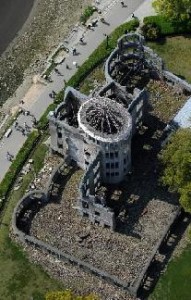- A-bomb Images
- Landmarks of Hiroshima: Atomic Bomb Dome
Landmarks of Hiroshima: Atomic Bomb Dome
by Masami Nishimoto, Editor and Senior Staff Writer
There are a host of landmarks in Hiroshima that urge us to ponder the question of war and peace. The Chugoku Shimbun introduces anew these buildings and monuments which recall the tragedy of the atomic bombing.
At 8:15 a.m. on August 6, 1945, an atomic bomb dropped on Hiroshima by the United States Army Air Forces exploded 600 meters above the ground about 160 meters southeast of the elliptical dome. Due to the tremendous blast, heat, and radiation unleashed by the uranium bomb called “Little Boy,” some 130,000 to 150,000 people were dead by the end of 1945 (according to the estimate submitted by the City of Hiroshima to the United Nations in 1976). The area within roughly two kilometers of the hypocenter was reduced to rubble, with 92 percent of the approximately 76,000 wooden buildings and other structures in this vicinity burned and destroyed.
The Hiroshima Prefectural Industrial Promotion Hall, now known as the A-bomb Dome, was almost directly beneath the hypocenter. The blast therefore hit the building from above, which enabled the iron framework of the roof and some of the brick walls to remain standing. The building was designed by the Czech architect Jan Letzel (1880-1925), and constructed in 1915. At that time Hiroshima still had the air of an old castle town, and this western-style building of five stories became a new landmark in the city. There were spiral staircases inside, a fountain in the garden, and the Motoyasu River flowed right by. Children in the neighborhood found the area around it an appealing place to play.
Tsuneo Kasai, 77, was born and raised in Sarugaku-cho (now Otemachi, Naka Ward), where the building formerly called the Industrial Promotion Hall was located. He says, “Even today, I don't want to look at the A-bomb Dome because it reminds me of my mother, whose skull was found, and my father, who went missing.”
In order for the tragic facts of the bombing to be made known to future generations, and to serve as a lesson for humanity, the City of Hiroshima carried out the first round of preservation work on the A-bomb Dome in 1967 with contributions coming from throughout Japan. In 1995, the A-bomb Dome was designated a historic site by the Japanese government, and in 1996, it was added to the UNESCO World Heritage list as the “Hiroshima Peace Memorial (Genbaku Dome).”
(Originally published on May 2, 2011)
Atomic Bomb Dome holds lesson for humanity
There are a host of landmarks in Hiroshima that urge us to ponder the question of war and peace. The Chugoku Shimbun introduces anew these buildings and monuments which recall the tragedy of the atomic bombing.
At 8:15 a.m. on August 6, 1945, an atomic bomb dropped on Hiroshima by the United States Army Air Forces exploded 600 meters above the ground about 160 meters southeast of the elliptical dome. Due to the tremendous blast, heat, and radiation unleashed by the uranium bomb called “Little Boy,” some 130,000 to 150,000 people were dead by the end of 1945 (according to the estimate submitted by the City of Hiroshima to the United Nations in 1976). The area within roughly two kilometers of the hypocenter was reduced to rubble, with 92 percent of the approximately 76,000 wooden buildings and other structures in this vicinity burned and destroyed.
The Hiroshima Prefectural Industrial Promotion Hall, now known as the A-bomb Dome, was almost directly beneath the hypocenter. The blast therefore hit the building from above, which enabled the iron framework of the roof and some of the brick walls to remain standing. The building was designed by the Czech architect Jan Letzel (1880-1925), and constructed in 1915. At that time Hiroshima still had the air of an old castle town, and this western-style building of five stories became a new landmark in the city. There were spiral staircases inside, a fountain in the garden, and the Motoyasu River flowed right by. Children in the neighborhood found the area around it an appealing place to play.
Tsuneo Kasai, 77, was born and raised in Sarugaku-cho (now Otemachi, Naka Ward), where the building formerly called the Industrial Promotion Hall was located. He says, “Even today, I don't want to look at the A-bomb Dome because it reminds me of my mother, whose skull was found, and my father, who went missing.”
In order for the tragic facts of the bombing to be made known to future generations, and to serve as a lesson for humanity, the City of Hiroshima carried out the first round of preservation work on the A-bomb Dome in 1967 with contributions coming from throughout Japan. In 1995, the A-bomb Dome was designated a historic site by the Japanese government, and in 1996, it was added to the UNESCO World Heritage list as the “Hiroshima Peace Memorial (Genbaku Dome).”
(Originally published on May 2, 2011)







